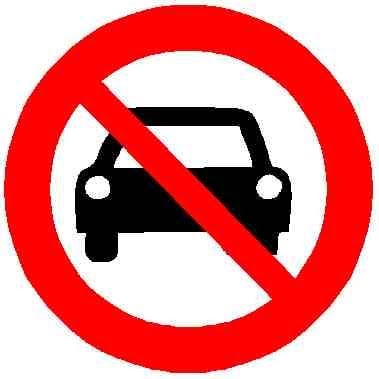Ever since ditching car culture and joining the urbanist cause (on the internet at least but that has to change), I’ve noticed that some countries always top the list when it comes to good urbanism. The first and most oblivious one tends to be The Netherlands but Germany and Japan also come pretty close. But that’s strange considering that both countries have huge car industries. Germany is (arguably) the birthplace of the car (Benz Patent-Motorwagen) and is home to Volkswagen, Mercedes-Benz and BMW. Japan is home to Toyota, Honda, Nissan and among others. How is it that these countries have been able to keep the auto lobby at bay and continue investing in their infrastructure?
Infrastructure funding for other transportation modes combined with less subsidizing of gasoline.
…they export the horrible machines?
Germany is very car centric and most German cities ore hideous. Germany should not be in the name conversation as Japan when it comes to urban planning.
…while Japanese cities are beautiful…LMAOOOO
You can usually get around the bigger cities without a car but once you leave the cities its horrible. Also, our railway system Is ducked to a point where driving schedules can’t really be calculated anymore.
Germany is very car centric and most German cities ore hideous.
“Japan” doesn’t necessarily have great urban planning; some Japanese cities have it. It also is somewhat getting worse in the countryside due to depopulation out here. I ended up having to buy a car where I live now (though it is a 660cc kei car) in part because I do some farming and need to buy bigger things, but also because cycling to the supermarket/drugstore/train station (all in the same place) would involve crossing some busy roads where people are speeding constantly. When it’s just me, I take my motorcycle, but often it’s both the wife and I. It’s not all Tokyo, Osaka, etc. Even Nagoya, one of the biggest cities, is super car-centric.
The Shinkansen is absolutely great and I love traveling in Japan by train, much better experience overall than Germany. That said, there are still so many things that are oddly outdated. Like, why is there no app to book tickets? Even when booking online, physical tickets are still needed and have to be collected at the train station.
Now with the typhoon a lot of connections were cancelled. Hundreds of people had to go to physical counters to exchange their physical tickets to cash. Because there’s an emergency schedule on some lines, the ticket machines don’t work and customers have to go to counters to get tickets. Even Germany is more digitized than that. Granted, Germany has a lot more experience with cancelled train connections…
It’s like, Japan was ahead of everyone else and just stopped there. Still a great experience but it could be so much better with relatively little effort.
You can book through the JR app (EkiNet, though it is kinda shit), IIRC. Definitely through their website. I don’t believe you need a physical ticket anymore, either, if your phone functions as your IC card (I’m not sure about actual IC cards, but I assume it’s the same). I do end up getting physical tickets most of the time because my local train gets shut down somewhat regularly and doesn’t run for hours at a time making it hard to know when to book in advance.
That said, we definitely need to do better at digitalization here in Japan. Even what is there for the government is pretty limited and, when it works, has an abysmal UX.
Well they basically started again in the late 40s…
Prior to that, Hitler saw the rise of the car and made Volkswagen and the Autobahn.
When you purposely build for pedestrianisation as well as motor vehicles, you get good results. Japan and Germany and majority of other nations didn’t sacrifice one for the other but built them up holistically together.
Neither Hitler the shitstain himself, nor the NSDAP invented the Autobahn. That was propaganda and is well known as a myth, today.
Sadly german planners post-war were influenced by the stupidity that was called Athens Charta. Many cities were built as “autogerechte Städte” with the car in mind first. Yes, pedestrians and cyclists were considered, but as an afterthought. Bike lanes and sidewalks were crammed together, they built tunnels under the roads to cross them without danger (you can imagine how safe those are considered, especially at night). By US american standard, that seems kind of okayish, but from from a present german perspective, the car-centric city was a big mistake, that is dismantled in many places, but sadly not everywhere.
Ah ok. My apologies.
No need to, but thanks for being nice. :)
I reckon being bombed to oblivion during World War 2 gave opportunity for re-designing their cities.
Not at all, at least in the case of Japan. Most of their roads are old and narrow, designed before cars were a thing.
Large export markets.
Both germany and japan have really strong car culture and fucked up rural infrastructure . The cities having nice public transit ≠ the country.
You can take a train to nearly every corner of japan. Japanese cities make sure you have a parking spot before you can buy a car. There is very little on street parking so many streets are open. The streets are narrow and often able to be shared between pedestrians and slow traffic. Roads specifically meant for cars are often seperated from pedestrians.
Japan has done a lot more than most other countries. Rural areas will always be more difficult to service due to their density but i still think japan has done better there than most.
Thier housing culture also makes it easier to move where you want to, which should make moving from rural to the city more feasable for those whom can’t handle the rural lifestyles.
In the popular perception sure. Having lived in Japan, reality is far different. Anywhere outside of cities has no sidewalk, in places where there would be some in europe. Train stations that are rural have no bus connections at all (having grown up in switzerland, this was hard to get used to). Cars are seen very highly, to the point where they have priority over everything else in planning.
And for tourists, sure the shinkanzen is cheap, because the tourism tickets are affordable, but the average person can barley afford it. And most use planes to get around where could be covered by shinkanzen.
Japan is similar to France, excellent tranit in between cities (fast trains; but expensive), cities have a robust network. But the rest of the country is unlivable without a car.
Switzerland is very car centric too, and we’re less good at high speed trains and comprehensive urban transit. But man, the rural trains + buses means you can get literally anywhere without a car. Japan doesn’t have that at all, despite being extremely dense like switzerland.
One factor that may ‘help’ japan in getting less car-centric over time is that the japanese rural areas and the smallest rank of cities are basically depopulating (dying out), with young people (and not so young too) moving to large cities and metropolises (like Tokyo). So, more % of japanese people will live in the not car-centric areas. Tourism will of course exist for some rural and small urban areas, but that occasional use can be served by short term car rentals.
Switzerland is very car centric too, and we’re less good at high speed trains and comprehensive urban transit.
Maybe, but Switzerland has the most rail usage per capita making it arguably the most rail centric country in the world.
we do. But still everything is built for cars and train is a second thought. We have great infrastructure, because in the past this was different. But currently, we’re barely investing in the train system, the infrastructure is starting to bottleneck (the Geneva - Lausanne axis is a disaster already), whilst we are adding more and more highway lanes. The far right party has had control over the transport ministry for a while now, and it is showing.
Im plagued by a north american perspective where anything more than hourly bus service is considered excellent transit service. I’m steps from downtown in my city and even downtown there are streets with sidewalks only along one side, causing extra time and crossings for pedestrians.
Japan absolutely hasn’t commited to car priority, if they did they would have abolished proof of parking spots for ownership and would jave opened nearly every square inch of their cities as free on street parking. They may be giving cars more space and priority than in the past but they havent bulldozed half their city for surface level parking and 6+ lane roads (or at least they haven’t done so as extremely as north america). Japan can still shift away from car ownership being madatory for life, much of north america is already trapped in that mindset.
I’ve also lived in Japan and my experience is that people rarely fly domestically and almost always take the train. But since domestic travel is so expensive, their vacations are often international instead of within Japan.
Definitely not the case where I lived (rural Niigata prefecture), but I was friends with people who were definitely poor.
James May of Top Gear fame actually went into this in an episode of “Cars of the People” season 2 episode 1. Basically, he claims it was actually World War II that set things on that course. Pretty enlightening episode IMHO. Worth a watch for a history lesson.
So having been to Japan and ridden the trains there I genuinely can’t imagine Tokyo where everyone drives. And once you have that and the Shinkansen you may as well build out a strong train network. But also, in bumfuck Japan everyone drives. Just because you can take a train to the middle of nowhere doesn’t mean you don’t need to drive when you get there
I think for Germany it’s simply the fact that our infrastructure grew in large parts before the invention of the car, plus it’s, compared to the US, very densely populated. So it’s easier to create a useful rail system, there isn’t enough space in the cities for to many cars, even though there are way to many for my taste.
So you’re focused on withstanding road brain.
After WW2 everyone was broke. In Germany there was no money to build new massive freeway projects. No one had money to buy cars anyway. You can watch the movie “Judgment at Nuremberg”, it’s fiction but one thing that stuck out to me was people riding bicycles. They also had a lot of things to focus on. It took a long time to get things back on track.
Japan also had no money, though they did try the car thing for a while afaik. There were many problems. First was there was not much room for the cars and car parks. Second was there was no massive domestic gasoline production. I think they finally realized that if everyone drove like Americans, that they would be sending a ton of money outside the country for oil.
I don’t think this is the cause of it though: No money for buying cars. My guess is, it’s because there were more alternatives such as trains and public trams and cities are more densely build out of history.
Despite the US, Germany(& Europe) and Japan had a huge railway network spanning all cities and even smaller cities. The area I lived in Germany had the first railway 1840. Japan 1872. US 1827. However, if you look into the network expansion the US never reached the density and complexity of both others due to it’s sheer size.
With the advent of trains all bigger European and Japanese cities began to build public tram systems. To such an extent that it spans most of the citied nowadays. This is still not the state in US. One can literally see the difference when visiting US, German, and Japanese cities todays.
Moreover, US hadn’t cities that grow organically throughout the centuries. And there is much space available. No dense historic city centers, no growing city rings. E.g. you can easily cross an one million city such as Cologne by bike in 1-1,5 hour. (And adding traffic jams and parking lot search time, bike is more efficient and easy)
Interactive map railway network Germany: https://interaktiv.morgenpost.de/bahn-schienennetz-deutschland-1835-bis-heute/
Video railway network Japan https://jref.com/threads/video-150-years-of-japan-railway-network.504981/
Video railway network US https://youtu.be/a8lX5A2q-Eo?si=-zjdLE1Wz8TlyCbt. Wiki https://en.m.wikipedia.org/wiki/History_of_rail_transportation_in_the_United_States
Public tram systems in US https://en.m.wikipedia.org/wiki/List_of_streetcar_systems_in_the_United_States
there were more alternatives such as trains and public trams
Which is the cause and which is the effect?
If people have no money for cars, they will demand transit. If the government has no tax money for massive infrastructure projects, but people are still demanding something, they will give buses which are cheap. Then the demand and mentality is to upgrade those to trains.
As the engine car was invented in 1886, I would say trains and trams were already there. Way before the car entered the scene. Just later at 1908 with Ford T cars became affordable for the non-rich.
People at that time hadn’t a huge radius of movement. There wasn’t simply not much need.
Yeah that why I talk about people not being able to afford them after ww2. And government not behind able to afford infrastructure after ww2. I don’t know why you insist on looking at the ancient past when post WW2 is the important part here. Heck WW1 too, it cost a shit ton. These were the pivotal events that shaped the modern world.
Okay, I might sound too negative. After WW2 car culture took off in Germany and Japan as well. May be a bit later due to overall wealth.
However, the OT asked how it comes that both countries have different urban planning - not building the city around cars despite having big car manufacturers.
My point is simply that the structure of German and Japanese cities were already shaped when cars were invented. Sure, there were bigger „modernizations“ with big streets cutting some cities in halves. But that’s more a niche.
The US had a population boom after WW2 and so the cities start to spread. Build car-friendly. https://marketsize.net/wp-content/uploads/2016/12/USPop.jpg
They’re not violent empires who can massively exploit people and the planet in order to afford a grossly wasteful and inefficient lifestyle.
anymore *
Dunno… Maybe because the companies are not in charge of running the country?
And on top of that, i believe most of those cars are sold in the US…
For most german automakers the biggest market has actually been China for a while.
Ahh right on. Either case they are an export item that’s not staying in country.








